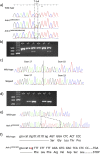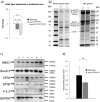A novel ENU-induced ankyrin-1 mutation impairs parasite invasion and increases erythrocyte clearance during malaria infection in mice
- PMID: 27848995
- PMCID: PMC5111128
- DOI: 10.1038/srep37197
A novel ENU-induced ankyrin-1 mutation impairs parasite invasion and increases erythrocyte clearance during malaria infection in mice
Abstract
Genetic defects in various red blood cell (RBC) cytoskeletal proteins have been long associated with changes in susceptibility towards malaria infection. In particular, while ankyrin (Ank-1) mutations account for approximately 50% of hereditary spherocytosis (HS) cases, an association with malaria is not well-established, and conflicting evidence has been reported. We describe a novel N-ethyl-N-nitrosourea (ENU)-induced ankyrin mutation MRI61689 that gives rise to two different ankyrin transcripts: one with an introduced splice acceptor site resulting a frameshift, the other with a skipped exon. Ank-1(MRI61689/+) mice exhibit an HS-like phenotype including reduction in mean corpuscular volume (MCV), increased osmotic fragility and reduced RBC deformability. They were also found to be resistant to rodent malaria Plasmodium chabaudi infection. Parasites in Ank-1(MRI61689/+) erythrocytes grew normally, but red cells showed resistance to merozoite invasion. Uninfected Ank-1(MRI61689/+) erythrocytes were also more likely to be cleared from circulation during infection; the "bystander effect". This increased clearance is a novel resistance mechanism which was not observed in previous ankyrin mouse models. We propose that this bystander effect is due to reduced deformability of Ank-1(MRI61689/+) erythrocytes. This paper highlights the complex roles ankyrin plays in mediating malaria resistance.
Figures




Similar articles
-
Ankyrin-1 Gene Exhibits Allelic Heterogeneity in Conferring Protection Against Malaria.G3 (Bethesda). 2017 Sep 7;7(9):3133-3144. doi: 10.1534/g3.117.300079. G3 (Bethesda). 2017. PMID: 28751503 Free PMC article.
-
A novel ENU-mutation in ankyrin-1 disrupts malaria parasite maturation in red blood cells of mice.PLoS One. 2012;7(6):e38999. doi: 10.1371/journal.pone.0038999. Epub 2012 Jun 19. PLoS One. 2012. PMID: 22723917 Free PMC article.
-
Novel roles for erythroid Ankyrin-1 revealed through an ENU-induced null mouse mutant.Blood. 2009 Apr 2;113(14):3352-62. doi: 10.1182/blood-2008-08-172841. Epub 2009 Jan 28. Blood. 2009. PMID: 19179303 Free PMC article.
-
Host-parasite interactions that guide red blood cell invasion by malaria parasites.Curr Opin Hematol. 2015 May;22(3):220-6. doi: 10.1097/MOH.0000000000000135. Curr Opin Hematol. 2015. PMID: 25767956 Free PMC article. Review.
-
Molecular Signaling Involved in Entry and Exit of Malaria Parasites from Host Erythrocytes.Cold Spring Harb Perspect Med. 2017 Oct 3;7(10):a026815. doi: 10.1101/cshperspect.a026815. Cold Spring Harb Perspect Med. 2017. PMID: 28507195 Free PMC article. Review.
Cited by
-
Ankyrin-1 Gene Exhibits Allelic Heterogeneity in Conferring Protection Against Malaria.G3 (Bethesda). 2017 Sep 7;7(9):3133-3144. doi: 10.1534/g3.117.300079. G3 (Bethesda). 2017. PMID: 28751503 Free PMC article.
-
ARGONAUTE2 Localizes to Sites of Sporocysts in the Schistosome-Infected Snail, Biomphalaria glabrata.Genes (Basel). 2024 Aug 3;15(8):1023. doi: 10.3390/genes15081023. Genes (Basel). 2024. PMID: 39202383 Free PMC article.
-
A novel ENU-induced Cpox mutation causes microcytic hypochromic anemia in mice.Exp Anim. 2022 Nov 10;71(4):433-441. doi: 10.1538/expanim.22-0032. Epub 2022 May 9. Exp Anim. 2022. PMID: 35527013 Free PMC article.
-
Host genetics in malaria: lessons from mouse studies.Mamm Genome. 2018 Aug;29(7-8):507-522. doi: 10.1007/s00335-018-9744-9. Epub 2018 Mar 28. Mamm Genome. 2018. PMID: 29594458 Review.
-
RBC membrane biomechanics and Plasmodium falciparum invasion: probing beyond ligand-receptor interactions.Trends Parasitol. 2022 Apr;38(4):302-315. doi: 10.1016/j.pt.2021.12.005. Epub 2022 Jan 4. Trends Parasitol. 2022. PMID: 34991983 Free PMC article. Review.
References
-
- W.H.O. World Malaria Report 2015. (World Health Organisation (WHO), 2015).
Publication types
MeSH terms
Substances
Grants and funding
LinkOut - more resources
Full Text Sources
Other Literature Sources
Medical
Molecular Biology Databases

